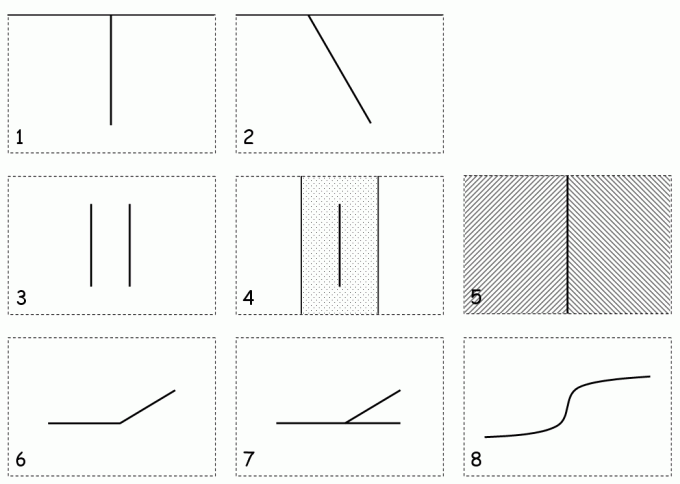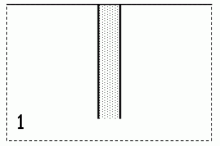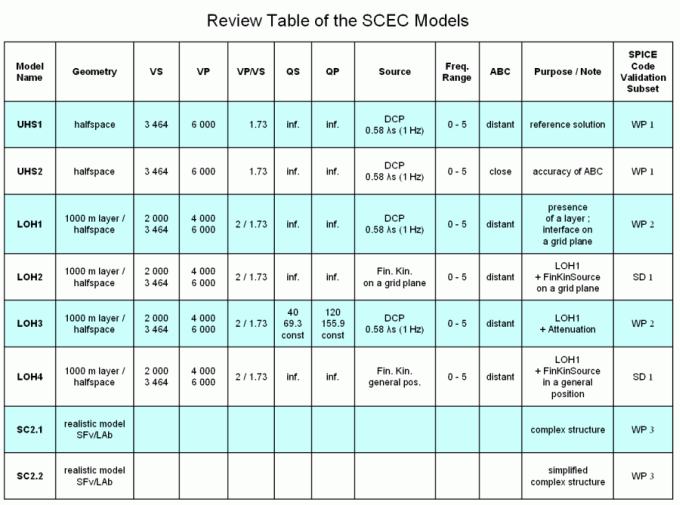Miriam Kristekova, Peter Pazak, Heiner Igel, Renata Tothova, and Martin Galis
(Version: February 28, 2006)
Review Table of the SCEC Models
Wave Propagation (WP) Model Set
Source Dynamics (SD) Model Set
Quantitative Misfit Criteria for Comparison of Seismograms
Interactive Web Interface
Aknowledgments
Introductory Remarks
The Southern California Earthquake Center (SCEC) organized the 3D Numerical Simulation Code Validation Project for wave propagation in the past years. Recently, SCEC organizes an earthquake source physics code validation/comparison exercise. The goal of both efforts is to validate 3D earthquake simulation methods and foster their application by engineering community. One set of computational models includes simple models of a homogeneous halfspace and layer over halfspace, as well as complex model of the San Fernando Valley / Los Angeles Basin region. The earthquake source validation set will similarly cover models starting from relatively simple ones up to complex real events.
Development of the earthquake motion numerical simulation methods is one of the primary goals of the Seismic Wave Propagation and Imaging in Complex Media: a European Network (SPICE), the EU FP6 project. SPICE provides a reasonable platform for a code validation effort in Europe.
At the Local Scale Task Group meeting in Zürich, March 10-15, 2005, a Focus Group ‘Code Validation’ with Peter Moczo (Comenius University, Bratislava, Slovakia) as a coordinator has been established.
The plan of the SPICE Code Validation was then elaborated by Peter Moczo, Jean Paul Ampuero, Jozef Kristek, Steven M. Day, Miriam Kristekova, Peter Pazak, Heiner Igel, Renata Tothova, and Martin Galis.
The main intention of the SPICE Code Validation effort is to create a long-term basis for possible tests/comparisons/validation of numerical methods and codes for the seismic wave propagation and earthquake motion simulation. The basis should serve even after the SPICE project is completed. The possibility to test methods/codes should be open and user-friendly for anybody interested in the use of the SPICE Code Validation models.
The Model Sets should be designed such that new models could be added in correspondence with progress in the numerical modeling methods. The long-term plan may include models for which we do not know reference solutions at present but it is very likely that the models/problems will be addressed in near future. Elaboration of the SPICE models started with the evaluation of the SCEC Code Validation. Based on the evaluation of the SCEC Code Validation and capabilities of recent numerical-modeling methods two model sets were elaborated: Wave Propagation ( WP ) Model Set and Source Dynamics ( SD ) Model Set.
Development of the earthquake motion numerical simulation methods is one of the primary goals of the Seismic Wave Propagation and Imaging in Complex Media: a European Network (SPICE), the EU FP6 project. SPICE provides a reasonable platform for a code validation effort in Europe.
At the Local Scale Task Group meeting in Zürich, March 10-15, 2005, a Focus Group ‘Code Validation’ with Peter Moczo (Comenius University, Bratislava, Slovakia) as a coordinator has been established.
The plan of the SPICE Code Validation was then elaborated by Peter Moczo, Jean Paul Ampuero, Jozef Kristek, Steven M. Day, Miriam Kristekova, Peter Pazak, Heiner Igel, Renata Tothova, and Martin Galis.
The main intention of the SPICE Code Validation effort is to create a long-term basis for possible tests/comparisons/validation of numerical methods and codes for the seismic wave propagation and earthquake motion simulation. The basis should serve even after the SPICE project is completed. The possibility to test methods/codes should be open and user-friendly for anybody interested in the use of the SPICE Code Validation models.
The Model Sets should be designed such that new models could be added in correspondence with progress in the numerical modeling methods. The long-term plan may include models for which we do not know reference solutions at present but it is very likely that the models/problems will be addressed in near future. Elaboration of the SPICE models started with the evaluation of the SCEC Code Validation. Based on the evaluation of the SCEC Code Validation and capabilities of recent numerical-modeling methods two model sets were elaborated: Wave Propagation ( WP ) Model Set and Source Dynamics ( SD ) Model Set.
Wave Propagation (WP) Model Set
Simplest canonical models designed to test accuracy of the schemes/codes with respect to individual factors/features of the models including ABCs ( includes SCEC_UHS1 and SCEC_UHS2 ).
| |||||||||||||||||||
SPICE Subset WP 2
Canonical models combining two or more basic structural features ( includes SCEC_LOH1 and SCEC_LOH3 ).
| |||||||||||||||||||||||||||||||
SPICE Subset WP 3
Realistic models ( includes SC_2.1 and SC_2.2 ).
|
Source Dynamics (SD) Model Set
SPICE Subset SD 1
Simplest canonical models with standard friction laws (slip weakening, velocity weakening, rate-and-state friction).

SPICE Subset SD 2
Canonical models include principal problem configurations.

SPICE Subset SD 3
Realistic models including standard friction laws, fluid interactions, thermal effects, damage mechanics, ...

Quantitative Misfit Criteria for Comparison of Seismograms
Interactive Web Interface
The interactive web interface has been developed by the SPICE team at the Comenius University in Bratislava. The interface will serve to organizers and voluntary participants of the SPICE Code Validation.
The use of the interface is easy and the web pages navigate participant step by step from the model selection up to comparison of his solution with a reference or any other selected solution.
Each participant can, in principle, use several computational methods/codes and upload several solutions for each model.
The use of the interface is easy and the web pages navigate participant step by step from the model selection up to comparison of his solution with a reference or any other selected solution.
Each participant can, in principle, use several computational methods/codes and upload several solutions for each model.
Acknowledgments
The PHP code generating the dymanic HTML pages was inspired by the examples provided by Michael Ewald, LMU Munich.
| Interface uses a free MySQL database. |  |
